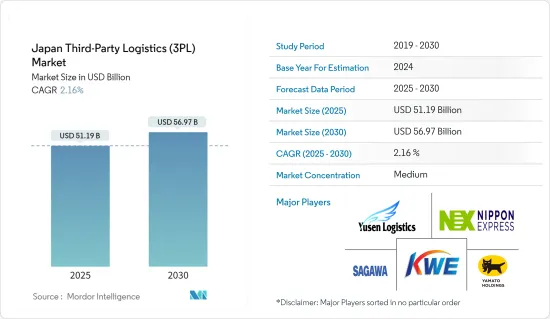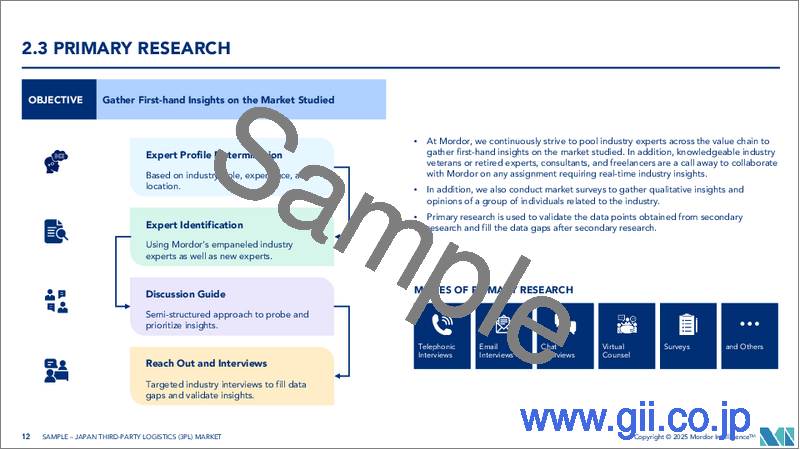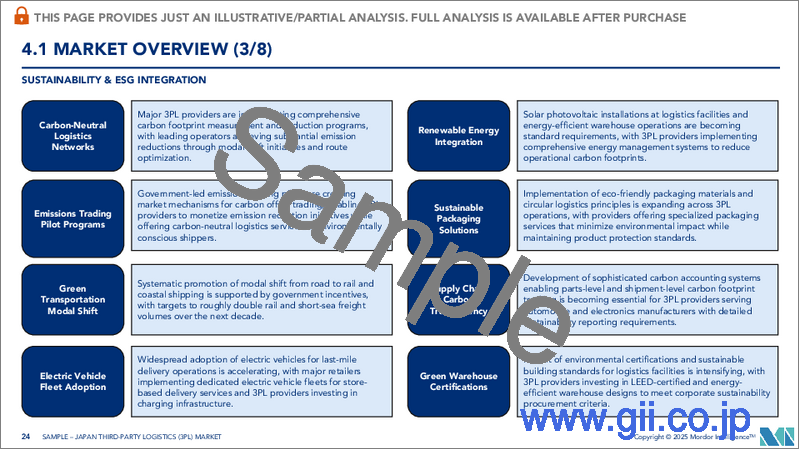|
|
市場調査レポート
商品コード
1690173
日本のサードパーティロジスティクス(3PL)-市場シェア分析、産業動向・統計、成長予測(2025年~2030年)Japan Third-Party Logistics (3PL) - Market Share Analysis, Industry Trends & Statistics, Growth Forecasts (2025 - 2030) |
||||||
カスタマイズ可能
適宜更新あり
|
|||||||
| 日本のサードパーティロジスティクス(3PL)-市場シェア分析、産業動向・統計、成長予測(2025年~2030年) |
|
出版日: 2025年03月18日
発行: Mordor Intelligence
ページ情報: 英文 150 Pages
納期: 2~3営業日
|
全表示
- 概要
- 目次
日本のサードパーティロジスティクス市場規模は2025年に511億9,000万米ドルと推定され、予測期間(2025年~2030年)のCAGRは2.16%で、2030年には569億7,000万米ドルに達すると予測されます。

主なハイライト
- COVID-19の流行は、物品の移動、保管、輸送を行う物流企業に直接的な影響を与えました。物流企業は、企業のビジネスを支援し、製品を顧客に届ける。ロジスティクス企業は、企業のビジネスを支援し、製品を顧客に届ける。ロジスティクス企業は、国境の内外を問わず、バリューチェーンの重要な一部となっています。したがって、パンデミックによって引き起こされるサプライチェーンの中断は、この部門の競争力、経済拡大、雇用創出に影響を与える可能性があります。
- 日本はサプライチェーン分野において、これまで多くの進歩を遂げてきました。例えば、伝統的な産業を変えるためにデジタル技術を取り入れました。ここ数年、ロジスティクスに影響を与える社会的・経済的要因は大きく変化しています。これらの要因には、人口の減少や高齢化、一部の分野における新しいアイデア、より小さな商品の配送頻度の増加、異なる顧客ニーズなどが含まれます。日本では、大企業が自社の物流ネットワークの仕組みに注目し、コスト削減と効率化のために、より多くの業務を3PL業者に委託するようになり、3PLに対する需要が高まっています。
- 3PLロジスティクス企業は、サプライチェーンを運営し、材料や商品をあらゆる産業や消費者に届ける存在です。東アジアで最大の経済大国のひとつである日本は、製造業のため3PLロジスティクスに多くを依存しています。その結果、ヤマトホールディングスのような組織は、世界でもトップクラスのロジスティクス・プロバイダーとなっています。列島の1億2,000万人が47億1,000万トンの国内貨物を扱い、対外貿易はさらに9億トンを追加しました。
- 2000年以降、日本では大規模で近代的な物流賃貸施設に対するニーズが大きく高まっています。物流業務のアウトソーシング、企業不動産の不均衡、複数の古い倉庫からの退去などがすべて、この上昇に貢献しました。日本における貨物・物流産業は、GDPの5%以上を占める大きな部分を占めています。
- 物流事業は熾烈なコスト競争力で知られています。ライバルに打ち勝つためには、高度な連携とスケールメリットが求められます。サード・パーティーロジスティクス」、通称「3PL」の活用により、物流企業は業務の合理化に乗り出しています。自動化と人工知能(AI)は、コスト管理のためのさらなるツールです。
ロジスティクス・システム業界は、こうした技術的ソリューションをさらに取り込んで成長していくと思われます。自動倉庫は現在使用されているが、完全な自律走行トラックが道路を走るようになるまでには、まだ時間がかかると思われます。日本にとって、自動化の進歩はすぐには訪れないです。物流部門は人手不足に陥っており、その上ドライバーの高齢化が急速に進んでいるため、適正価格でのサービス提供が危ぶまれています。この取り組みの2つの目標は、トラック運送部門の生産性を向上させることと、高齢のドライバーや女性ドライバーを惹きつけ、維持できる職場環境を育成することです。自動化がさらに進むまで、この戦術が市場を十分に効果的に安定させるかどうかは見守る必要があります。
日本のサードパーティーロジスティクス(3PL)市場の動向
自動車産業と製造業の成長が市場を牽引
日本は製造機械と自動車産業において、常に世界的リーダーの1つです。経済産業省(METI)によれば、ハイテク製造業は日本の最も重要な成長分野の一つです。日本の製造業の中核分野は、家電、自動車製造、半導体製造、光ファイバー、オプトエレクトロニクス、光学メディア、鉄鋼、コピー機などです。
古くから日本は世界有数の自動車輸出国でした。高品質の製造と効率的な物流サービスで知られています。高度に開発されたインフラと港湾ネットワークが輸出大国としての地位を支えており、船会社が密集していることもその理由です。
日本の自動車産業の大手企業の中には、社内にロジスティクス部門を持つ企業もあります。日本の大手自動車ロジスティクス・プロバイダーであるバンテックは、HTSグループ傘下にあります。バンテック・グループは、自動車メーカーの複雑な物流要件に完全に合致した自動車部品の順次供給をサポートしています。
日野自動車が考える未来のモビリティ社会は、「SPACE」という言葉で表現されます。"シェアード(移動・空間・時間の共有)""Platform(様々なサービスに自由に対応)"と"Autonomous(運転からの解放)"と"Connected(モビリティと人・モノ・街をつなぐ)"と"Electricity(効率性と柔軟性の向上)"。
コールドチェーン物流の開発
日本は、米国に次いで世界で2番目に急成長している成熟医薬品市場です。日本の医薬品市場に対する国際的な関心は、コールドチェーン物流サービス・プロバイダーにチャンスをもたらすと思われます。国内の企業は、競合他社や3PL企業にプラットフォームサービスを提供する企業との取引、提携、契約を通じて、サービスの改善や更新を激しく行っています。
コールドチェーン市場は、その過程で必要とされるエネルギー量と、発生する膨大な排出量でも知られています。各社は物流センターを設置し、車両を環境にやさしく、排出ガスを最小限に抑え、持続可能なエネルギー源で走るものに変えています。
日本政府と国連児童基金(ユニセフ)は2022年2月20日、保健省とSAMESに冷蔵バン3台を贈呈しました。ディリにあるSAMESの施設では、キネフチ正美駐東ティモール日本大使とアイノア・ジャウレギベイティアUNICEF副代表が、ボニファシオ・マウコリ・ドス・レイス保健副大臣に車両を手渡しました。
さらに、アイナロ市、バウカウ市、ボボナロ市、オエクセ特別行政区のすべての地域倉庫にウォークインクールルームが提供され、現在設置中です。ワクチンを安全かつ迅速に町や医療施設に送るためには、冷蔵バン、ウォークインクーラー、冷凍室をすべての部品とともに用意することが重要です。
日本のサードパーティロジスティクス(3PL)業界の概要
市場はかなり小さく、最大手は郵船ロジスティクス、エクスペディターズ、DHL、日立物流、クーネ・ナーゲルです。また、自社でロジスティクスを扱う小売企業や製造企業も市場で大きな役割を果たしています。
日本のeコマース市場はかつてない勢いで成長しています。このことは、日本における付加価値サービスの急成長に反映されています。その結果、日本の物流業界では、梱包、ラベリング、仕分け作業が急増しています。
国内の高い需要と労働者不足に対処するために、複数の企業の商品を共通の配送ポイントに送る共同配送や共有配送、配送会社がトラックの空きスペースと荷送人を持つドライバーを見つけるのを助けるプラットフォームアプリ、中間配送センターとしての都市部の小規模倉庫の利用、収集物流といった手段を取ることができます。
自動運転の機械や車両の使用など、物流業界の変化の目標は、経済全体に対するこの部門の二酸化炭素排出量をなくすことです。
その他の特典:
- エクセル形式の市場予測(ME)シート
- 3ヶ月間のアナリスト・サポート
目次
第1章 イントロダクション
- 調査の成果
- 調査の前提
- 調査範囲
第2章 調査手法
- 分析手法
- 調査フェーズ
第3章 エグゼクティブサマリー
第4章 市場力学と洞察
- 現在の市場シナリオ
- 市場力学
- 促進要因
- 抑制要因
- 機会
- バリューチェーン/サプライチェーン分析
- 業界の規制と政策
- 倉庫市場の一般的動向
- CEP、ラストワンマイルデリバリー、コールドチェーンロジスティクスなど他のセグメントからの需要
- 電子商取引ビジネスに関する洞察
- 技術動向と自動化
- 業界の魅力- ポーターのファイブフォース分析
- 新規参入業者の脅威
- 買い手/消費者の交渉力
- 供給企業の交渉力
- 代替品の脅威
- 競争企業間の敵対関係の強さ
- COVID--19が市場に与える影響
第5章 市場セグメンテーション
- サービス別
- 国内輸送管理
- 国際輸送管理
- 付加価値型倉庫・物流
- エンドユーザー別
- 製造・自動車
- 石油・ガス・化学
- 流通業(eコマースを含む卸売・小売業)
- 製薬・ヘルスケア
- 建設
- その他のエンドユーザー
第6章 競合情勢
- 企業プロファイル
- Nippon Express
- Yamato Holdings
- Kintetsu World Express
- Sagawa Express
- Hitachi Transport System
- Nichirei Logistics
- Sankyu
- Kokusai Express
- Fukuyama
- Mitsui-Soko
- Alps Logistics
- Yusen Logistics
- DHL*
第7章 市場の将来
第8章 付録
- マクロ経済指標(GDP分布、活動別、運輸・倉庫部門の経済への寄与度)
- 対外貿易統計-輸出と輸入(製品別)
- 主要輸出先および輸入原産国に関する洞察
The Japan Third-Party Logistics Market size is estimated at USD 51.19 billion in 2025, and is expected to reach USD 56.97 billion by 2030, at a CAGR of 2.16% during the forecast period (2025-2030).

Key Highlights
- The COVID-19 epidemic had a direct effect on logistics companies, which move, store, and move goods.Logistics companies help businesses do business and get their products to customers. They became an important part of value chains both inside and outside of national borders. Hence, supply chain interruptions brought on by the pandemic could affect the sector's competitiveness, economic expansion, and job creation.
- Japan has made a lot of progress in the supply chain space over time. For example, it has embraced digital technologies to change a traditional industry. In the last few years, the social and economic factors that affect logistics have changed a lot. These factors include a shrinking or aging population, new ideas in some areas, more frequent deliveries of smaller goods, and different customer needs. In Japan, there is more demand for 3PL as large companies look at how their logistics networks work and outsource more tasks to 3PL providers to cut costs and improve efficiency.
- 3PL logistics firms are the ones who run supply chains and get materials and goods to all industries and consumers. Japan, one of the biggest economies in East Asia, relies on 3PL logistics a lot because of its manufacturing industry. As a result, organizations like Yamato Holdings are among the top logistics providers globally. 120 million people in the archipelago handled 4.71 billion tons of domestic freight, and foreign trade added 900 million tons more.
- Since 2000, there has been a big rise in the need for large, modern logistics leasing facilities in Japan. Outsourcing logistics operations, imbalances in corporate real estate, and moving out of multiple old warehouses all contributed to the rise. The freight and logistics industry in Japan is a big part of the economy, making up more than 5% of the GDP.
- The logistics business is known for its fierce cost competitiveness. To outbid rivals, sophisticated coordination and economies of scale are required. Through the use of "third-party logistics," sometimes known as "3PL," logistics firms have begun to streamline their operations. Automation and artificial intelligence (AI) are further tools for cost control.
It's likely that the logistics systems industry will grow to include more of these technical solutions. Although automated warehouses are now in use, it will be some time before fully autonomous trucks are allowed on the roads. Automation advancements cannot arrive soon enough for Japan. Its logistics sector is experiencing a manpower deficit, and on top of that, drivers are aging quickly, endangering the availability of services at fair prices. Two goals of this effort are to increase productivity in the trucking sector and to foster work environments that attract and retain older and female drivers. It has to be seen whether this tactic stabilizes the market effectively enough until automation advances further.
Japan Third-Party Logistics (3PL) Market Trends
Growth in automotive and manufacturing sector driving the market
Japan has always been and is one of the global leaders in the manufacturing machinery and automobile industries. The Ministry of Economy, Trade, and Industry (METI) says that high-tech manufacturing is one of Japan's most important growth sectors. The core areas in Japan's manufacturing sector are consumer electronics, automobile manufacturing, semiconductor manufacturing, optical fibers, optoelectronics, optical media, steel and iron, and copy machines.
Since a long time ago, Japan has been one of the top exporters of cars in the world. It is known for its high-quality manufacturing and efficient logistics services. Its highly developed infrastructure and port network support its status as an exporting giant, as do its dense concentration of shipping lines.
Some of the major players in the automotive industry in Japan also have in-house logistics arms. Vantec, a leading automotive logistics provider in Japan, operates under the HTS Group. The Vantec Group supports the sequential supply of auto parts in full alignment with the complex logistics requirements of automotive manufacturers.
As per Hino Motors, the future mobility society to be considered is represented by the word "SPACE". "Shared (sharing of movement, space, and time)" "Platform (corresponding to various services freely) and "Autonomous (free from driving)" "Connected (connecting mobility with people, things, and cities)" "Electricity" (increase efficiency and flexibility).
Development in cold chain logistics
Japan is the second-fastest-growing mature pharmaceutical market in the world, following the United States. The international interest in the Japanese pharmaceutical market will create opportunities for cold chain logistics service providers. The companies in the country are heavily improving and updating their services through deals, partnerships, and agreements with competitors and companies that provide platform services to the 3PL companies.
The cold chain market is also known for the amount of energy required in the process and the huge amount of emissions that occur. The companies are setting up logistics centers and transforming vehicles into ones that are environment-friendly, produce minimum emissions, and run on sustainable sources of energy.
The Government of Japan and the United Nations Children's Fund (UNICEF) gave three refrigerated vans to the Ministry of Health and SAMES on February 20, 2022. These vans will be used to move vaccines.At the SAMES compound in Dili, Masami Kinefuchi, the Japanese ambassador to Timor-Leste, and Ainhoa Jaureguibeitia, the deputy UNICEF representative, gave the vehicles to Sr. Bonifacio Maucoli dos Reis, the vice minister of health.
Moreover, walk-in cool rooms have been provided and are currently being installed at all regional warehouses in the municipalities of Ainaro, Baucau, Bobonaro, and the Special Administrative Area of Oecusse. It is important to have refrigerated vans, walk-in coolers, and freezer rooms with all of their parts so that vaccines can be kept safely and quickly sent to towns and medical facilities.
Japan Third-Party Logistics (3PL) Industry Overview
The market is pretty small, and its biggest players are Yusen Logistics, Expeditors, DHL, Hitachi Transport System, and Kuehne Nagel. Retail and manufacturing companies that handle their own logistics also play a big role in the market.
Japan's e-commerce market is growing at a rate that has never been seen before. This is reflected in the rapid growth of value-added services in Japan.As a result, packaging, labeling, and sorting activities have seen a large spike in the Japanese logistics industry.
To deal with the high demand and lack of workers in the country, steps can be taken like joint or shared delivery, which sends goods from multiple companies to common delivery points, platform apps, which help delivery companies find drivers with empty truck space and shippers, the use of small warehouses in cities as intermediate distribution centers, and collection logistics.
The goal of the changes in the logistics industry, like the use of self-driving machines and vehicles, is to get rid of the sector's carbon footprint on the economy as a whole.
Additional Benefits:
- The market estimate (ME) sheet in Excel format
- 3 months of analyst support
TABLE OF CONTENTS
1 INTRODUCTION
- 1.1 Study Deliverables
- 1.2 Study Assumptions
- 1.3 Scope of the Study
2 RESEARCH METHODOLOGY
- 2.1 Analysis Methodology
- 2.2 Research Phases
3 EXECUTIVE SUMMARY
4 MARKET DYNAMICS AND INSIGHTS
- 4.1 Current Market Scenario
- 4.2 Market Dynamics
- 4.2.1 Drivers
- 4.2.2 Restraints
- 4.2.3 Opportunities
- 4.3 Value Chain / Supply Chain Analysis
- 4.4 Industry Policies and Regulations
- 4.5 General Trends in Warehousing Market
- 4.6 Demand From Other Segments, such as CEP, Last Mile Delivery, Cold Chain Logistics Etc.
- 4.7 Insights on Ecommerce Business
- 4.8 Technological Trends and Automation
- 4.9 Industry Attractiveness - Porter's Five Forces Analysis
- 4.9.1 Threat of New Entrants
- 4.9.2 Bargaining Power of Buyers/Consumers
- 4.9.3 Bargaining Power of Suppliers
- 4.9.4 Threat of Substitute Products
- 4.9.5 Intensity of Competitive Rivalry
- 4.10 Impact of COVID--19 on the Market
5 MARKET SEGMENTATION
- 5.1 By Service
- 5.1.1 Domestic Transportation Management
- 5.1.2 International Transportation Management
- 5.1.3 Value-added Warehousing and Distribution
- 5.2 By End-User
- 5.2.1 Manufacturing & Automotive
- 5.2.2 Oil & Gas and Chemicals
- 5.2.3 Distributive Trade (Wholesale and Retail trade including e-commerce)
- 5.2.4 Pharma & Healthcare
- 5.2.5 Construction
- 5.2.6 Other End-Users
6 COMPETITIVE LANDSCAPE
- 6.1 Overview (market concentration and major players)
- 6.2 Company Profiles
- 6.2.1 Nippon Express
- 6.2.2 Yamato Holdings
- 6.2.3 Kintetsu World Express
- 6.2.4 Sagawa Express
- 6.2.5 Hitachi Transport System
- 6.2.6 Nichirei Logistics
- 6.2.7 Sankyu
- 6.2.8 Kokusai Express
- 6.2.9 Fukuyama
- 6.2.10 Mitsui-Soko
- 6.2.11 Alps Logistics
- 6.2.12 Yusen Logistics
- 6.2.13 DHL*
7 FUTURE OF THE MARKET
8 APPENDIX
- 8.1 Macroeconomic Indicators (GDP Distribution, by Activity, Contribution of Transport and Storage Sector to economy)
- 8.2 External Trade Statistics - Exports and Imports, by Product
- 8.3 Insights into Key Export Destinations and Import Origin Countries





